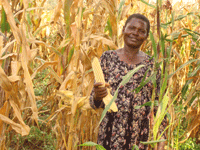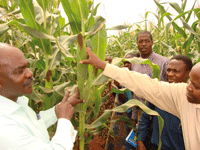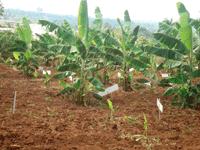
Fighting Africa’s food deficit
Legal Counsel for the African Agricultural Technology Foundation (AATF), Alhaji Tejan-Cole, explains what his organization is doing to help farmers in Africa increase productivity, profitability and sustainability to reverse the continent’s food deficit.
Experts have long agonized over how to produce higher crop yields and more nutritious foods from poor soils, to make food affordable for and accessible to Africa’s expanding population.

Farmer Julia Odhiambo from Kenya had
abandoned planting maize in this field
because of striga. With IR maize technology
she can now grow maize. (Photo: AATF)
As African farming is largely smallholder-based and most farmers still use inefficient practices that take a lot from the soil but give little in return, the prognosis is gloomy. With the current faith in market-based solutions, many of them can only slip into deeper poverty and deprivation.
The Food and Agriculture Organization (FAO) of the United Nations says that every 10 percent increase in smallholder agricultural productivity in Africa can lift almost 7 million people above the dollar-a-day poverty line.
Proprietary technologies to improve the drought tolerance, pest and disease resistance, yield potential and nutrient content of food crops are already being exploited in developed countries, with research companies coming up with better technologies every day.
While most smallholders in Africa seem resigned to the hit-or-miss character of their livelihood, they are keen to adopt new proprietary technology options where the right incentives and market opportunities exist.
With this in mind, the AATF was established to help small-scale farmers access and use these proprietary technologies to attain food security and reduce poverty.
Facilitating Technology Transfer
The Foundation identifies proprietary agricultural technologies that could benefit farmers. It then facilitates the transfer of these technologies and the associated know-how by negotiating royalty-free access for use in African farming systems. In so doing, AATF aims to address the legitimate concerns of both the technology providers and the users.
Although rich in natural and human resources, Africa is home to some 239 million undernourished people with an estimated 33 million children going to sleep hungry every night, according to the FAO. The Organization also notes that the rate of increase in undernourishment in Africa vastly exceeds that of other developing regions.
The big question is how to harness the best of science and technology to help the continent increase its agricultural productivity, profitability and sustainability and contribute to improved food security for all.
Between 1980 and 1995, Sub-Saharan Africa was the only region to experience a decrease in crop production, with average yields falling by 8 percent. This contrasts with an increase of 27 percent in Asia and 12 percent in Latin America.
A predominance of rain-fed, as opposed to irrigated, agriculture, minimal use of inputs and the lack of functioning competitive markets are just some of the problems facing African agriculture.
A great deal of effort has been directed at reversing this trend, but to little effect. Food aid continues to be a major part of the strategic response to curbing hunger. It is generally agreed, however, that an effective response to the food security crisis is to increase the yield potential of the land, rather than to expand the area of land under cultivation. Increased production per person engaged in agriculture is essential, because devastating problems such as HIV/AIDS, malaria and tuberculosis are reducing the productive capacity of the African labor force.

An IR maize technology demonstration
plot in Tanzania.
Certain proprietary technologies could be readily adapted to the agro-ecological conditions in the region and made available to poor farmers. Use of these technologies in the African context promises to stimulate broader and more equitable economic growth on a sustainable basis.
While international companies hold the intellectual property (IP) rights to most of these proprietary technologies, they have little commercial incentive to market them in Africa given the high costs of product identification, development and testing, regulatory approval, liability, manufacture and market development. Consequently, such companies focus on larger markets where they can more readily obtain a return on their investment.
The technologies sourced and promoted by AATF vary depending on the priority needs identified by farmers through sub-regional organizations and national agricultural research systems. They can include chemical, mechanical, biological and process solutions.
“We operate along the entire food chain to deliver proprietary agricultural technologies through innovative partnerships and effective technology and product stewardship,” says Dr. Daniel Mataruka, Executive Director of AATF.
The strengths of AATF’s partners lie in identifying, acquiring, adapting and delivering proprietary technologies to resource-poor farmers. Current partners include governments, farmers, agricultural producers and consumers and regional and national agricultural institutions and agencies.
The process begins by identifying, in collaboration with agricultural development organizations, the problems to be resolved. AATF then consults with proprietary technology holders to determine which technologies would be the most appropriate and effective in addressing the priorities identified by farmers.
Acting as an intermediary, AATF negotiates with technology owners on behalf of the eventual beneficiaries and, if successful, enters into licensing agreements that allow it to access and use the proprietary technology on a humanitarian, royalty-free basis. The Foundation then makes contractual agreements with institutions in the region and elsewhere for further research, adaptation and dissemination.
Major Projects
The Foundation is currently implementing five major projects, with several others in the pipeline. One of these is a project to control striga in maize. Also known as witchweed, striga is a parasitic weed that sucks nutrients from maize, reducing yields by up to 80 percent.

Bacterial wilt resistant banana on a
demonstration plot in Uganda.
AATF is promoting imazapyr-resistant (IR) (StrigAway®) non-transgenic maize seed, which has been shown to be effective against the weed, among farmers in East and Central Africa. The Striga Control Project is in its deployment stage, and AATF is working with key partners and a wide range of stakeholders to encourage farmers to test and adopt the technology.
In the western regions of Kenya for example, striga has caused farmers so much trouble that many associate its effects with witchcraft.
“As a herbalist, I have always believed in the traditional way of doing things, but today I can say that we must embrace the modern methods of agriculture”, says Kennedy Okumu one of the farmers now working with AATF to popularize imazapyr.
The use of IR maize technology to control Striga leads to yields 38 to 82 percent higher than those currently obtained from traditional maize varieties. In Kenya, a conservative estimate indicates that, when adopted, the proposed technology will lead to an extra 62,000 tons of maize in Western Province alone. This translates into US$5.3 million per year using 2002 estimates of farm-gate prices for maize in Kenya.
AATF is also developing maruca-resistant cowpea varieties - which are currently being field tested under controlled conditions - to tackle the pod borer (maruca vitrata). This pest inflicts severe damage on crops of cowpea in farmers’ fields, resulting in yield losses of between 70 to 80 percent. Due to high prices, farmers cannot afford insecticide spraying, and those that do spray are often exposed to serious health hazards. By facilitating development of transgenic cowpea varieties resistant to the maruca pest, AATF hopes to minimize insecticide use and its harmful effects on health and the environment.
The Foundation has accessed, through a royalty-free patent license, a gene conferring resistance to the maruca pod borer in cowpea, and is facilitating strict bio-safety regulatory compliance for its development and deployment in West Africa.
Yet another project seeks to improve the resistance of banana crops to bacterial wilt disease. Bananas and plantains are an important food source for over 100 million people in Sub-Saharan Africa. In the East African highlands and most of the Great Lakes region, bananas are a major staple food and a source of income for over 50 million smallholder farmers.
With an annual output of some 16.4 million metric tons, the region produces about one-fifth of the world’s bananas, but many biotic and abiotic factors still greatly reduce productivity. In 2001, an outbreak of banana bacterial wilt in Uganda caused economic loss of some US$200 million.
Another initiative is the development of improved rice varieties. AATF has negotiated a patent license for the technology with Arcadia Biosciences, which will perform plant transformation, greenhouse trials and field trials in the United States, then work with AATF-contracted researchers in Africa to transfer and adapt the technology.
The varieties developed will be nitrogen-efficient and salt-tolerant. They will accommodate the needs of farmers growing rice in the poorer highland soils with limited resources for fertilizers, as well as those growing rice in more saline lowland soils.
Rice is one of the most cultivated food crops in Africa, with consumption on the continent growing by about 6 percent annually. This demand has created an annual shortage of 6.5 million metric tons, a gap filled by imports that cost around US$1.7 billion every year.
Water Efficient Maize for Africa (WEMA)
AATF’s largest ongoing project is Water Efficient Maize for Africa (WEMA). Maize is the most widely grown staple crop in Africa, with more than 300 million depending on it as their main food source. It is, however, severely affected by frequent drought, leading to average yields almost seven times lower than those in other developed countries.
WEMA seeks to develop drought-tolerant African maize using conventional breeding, marker-assisted breeding and biotechnology. The benefits and safety of the maize varieties will be assessed by national authorities according to the strict bio-safety regulatory requirements in the participating countries of Kenya, Mozambique, South Africa, Tanzania and Uganda.
AATF is working with the International Maize and Wheat Improvement Centre (CIMMYT), Monsanto, and the respective countries’ agricultural research systems. CIMMYT provides high-yielding maize varieties that are adapted to African conditions and expertise in conventional breeding and testing for drought tolerance. Monsanto has provided proprietary germplasm, advanced breeding tools and expertise, and drought-tolerant transgenes developed in collaboration with German chemical company BASF.
The varieties developed through the project will be distributed by AATF, royalty-free, to African seed companies and made available to smallholder farmers. The national agricultural research systems, farmers’ groups and seed companies are contributing their expertise in field testing, seed multiplication and distribution.
Field trials have already been approved in Kenya, South Africa and Uganda, while regulatory approval is expected in Mozambique and Tanzania.
The conventional varieties are expected to be available around 2014, with transgenic varieties scheduled for deployment in 2017.
“The moderate drought-tolerant maize varieties expected from the project will result in an additional 2 million tons of maize in the participating countries, meaning that 14 to 21 million people will have more to eat and sell,” said WEMA Project Manager Dr. Sylvester Oikeh.
Collaborating with WIPO
The recently signed collaboration agreement between the AATF and the World Intellectual Property Organization (WIPO) moves one step closer in responding to the call by WIPO Director General Francis Gurry for member states to ensure the IP system serves as a stimulus for solving the global challenges confronting policymakers across the globe.
This collaboration also promises to show that the IP system serves the needs of developed as well as developing and least developed countries alike, and that Africa has the capacity to become a beneficiary of IP-related technology transfer.
The WIPO Magazine is intended to help broaden public understanding of intellectual property and of WIPO’s work, and is not an official document of WIPO. The designations employed and the presentation of material throughout this publication do not imply the expression of any opinion whatsoever on the part of WIPO concerning the legal status of any country, territory or area or of its authorities, or concerning the delimitation of its frontiers or boundaries. This publication is not intended to reflect the views of the Member States or the WIPO Secretariat. The mention of specific companies or products of manufacturers does not imply that they are endorsed or recommended by WIPO in preference to others of a similar nature that are not mentioned.